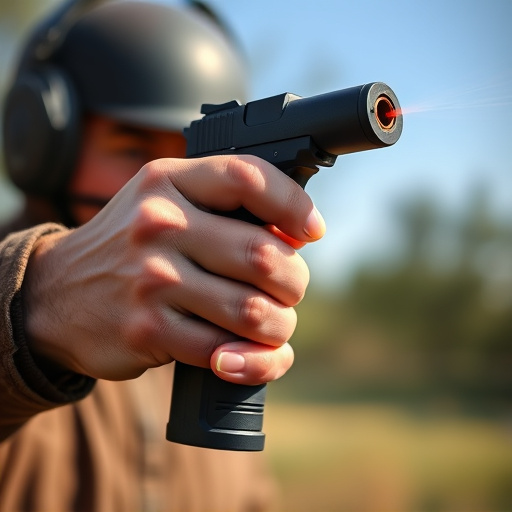Tactical pepper spray, a powerful non-lethal self-defense tool, utilizes capsaicin with carriers and additives to temporarily disable assailants. Its various forms include mist or aerosol deployment via simple triggers. Effective use requires understanding deployment methods, aiming techniques, product specifications, local laws, and considering it as a last resort after de-escalation efforts. When selecting a spray, tailor the choice to specific needs, focusing on capsaicin concentration, range, trigger reliability, advanced features, reputable brands, legal restrictions, and suitable deployment methods like wands for tight spaces.
“Tactical pepper spray is a powerful self-defense tool that can provide crucial moments of safety in threatening situations. Understanding its composition, deployment methods, and effectiveness is essential for anyone looking to protect themselves. This article delves into the world of tactical pepper spray, exploring its deployment techniques, legal considerations, and safety precautions. We’ll also guide you through choosing the right device, highlighting features that matter most when it comes to self-defense. Learn about various deployment methods and gain insights to enhance your personal safety.”
- Understanding Tactical Pepper Spray: Its Composition and Effectiveness
- Deployment Techniques: When and How to Use Pepper Spray
- Legal Considerations and Safety Precautions for Self-Defense
- Choosing the Right Pepper Spray Device: Features and Tips
Understanding Tactical Pepper Spray: Its Composition and Effectiveness
Tactical pepper spray is a powerful non-lethal self-defense tool designed to incapacitate an assailant temporarily, providing users with precious time to escape or seek help. Its composition typically includes capsaicin, the active ingredient found in chili peppers, combined with various carriers and additives to enhance its effectiveness and ease of application. This potent blend irritates the eyes, nose, and throat, leading to temporary blindness, coughing, and difficulty breathing, thereby disorienting and neutralizing the attacker.
Deployment methods for tactical pepper spray vary, but they generally involve a simple trigger mechanism that releases a concentrated mist or aerosol. Users can employ various techniques, such as aiming at the face, eyes, or breathing area, to ensure maximum impact. The spray’s range and duration of effect differ based on the product, with some specialized models designed for close-quarters combat and others suitable for longer distances. Understanding these factors is crucial in selecting an effective tactical pepper spray that aligns with individual needs and enhances overall safety.
Deployment Techniques: When and How to Use Pepper Spray
When it comes to tactical pepper spray deployment methods, timing and technique are paramount. The best time to use pepper spray is during an attack when your safety is at risk. Aim for the attacker’s face, eyes, and nose—these areas are highly sensitive to capsaicin, the active ingredient in pepper spray. A direct hit can temporarily disable an assailant, giving you precious seconds to escape or call for help.
Remember, using pepper spray should be a last resort when all other de-escalation attempts have failed. It’s crucial to familiarize yourself with local laws and regulations regarding its use, as well as practice deployment techniques through realistic training scenarios. This ensures that in a high-stress situation, you can act swiftly and effectively while minimizing the risk of excessive force or legal repercussions.
Legal Considerations and Safety Precautions for Self-Defense
When considering tactical pepper spray as a self-defense tool, it’s crucial to understand the legal implications and safety precautions surrounding its use. Laws regarding pepper spray vary significantly from region to region, with some areas restricting its sale and possession without a permit. Before deploying any form of self-defense, individuals should familiarize themselves with local legislation to avoid legal repercussions. It’s essential to only use pepper spray when necessary for personal safety, adhering to principles like the ‘use of force continuum’ where the response matches the threat level.
Safety precautions include proper training in tactical pepper spray deployment methods to ensure effective and safe usage. This involves learning the appropriate distance, angle, and pressure points for application, minimizing potential harm to bystanders or oneself. Regular maintenance and understanding of the spray’s shelf life are also vital, as is keeping it out of reach of children and unauthorized individuals.
Choosing the Right Pepper Spray Device: Features and Tips
When selecting a tactical pepper spray device, consider your specific needs and intended deployment methods. Look for features like a strong concentration of capsaicin (the active ingredient), a range that suits your purpose, and a reliable trigger mechanism. Some models offer advanced features like glow-in-the-dark components or multiple deployment options, such as canisters, wands, or even spray belts.
For optimal effectiveness, choose a brand known for quality and consistency in its products. Ensure the spray is easy to access and use during tactical situations, with minimal training required. Familiarize yourself with local laws regarding pepper spray ownership and carry, as well as any specific deployment methods permitted, such as tactical pepper spray deployment from distance or in confined spaces (e.g., using a wand for better control in tight areas).
Tactical pepper spray is a powerful self-defense tool, offering effective protection against assaults. By understanding its composition, learning deployment techniques, and considering legal boundaries, individuals can make informed decisions about this potent defense mechanism. With the right choice of device and proper application methods, tactical pepper spray can provide peace of mind in potentially dangerous situations. Remember, while it’s an excellent option for self-defense, responsible use is key to ensuring safety and minimizing unintended consequences.
